An Owl Tour today. The weather forecast was not ideal. It started fine, with a lovely sunrise, but clouded over quickly and the wind picked up. There was some light drizzle too through the middle of the day but it wasn’t enough to put us off, and the rain stopped mid afternoon, so we were able to make the most of it. And see some owls!
After meeting up, we headed straight down to the coastal grazing marshes in the hope we might be able to find a late Barn Owl still out hunting. As we scanned the grass, there was no sign of any at first. It was a lovely bright morning, after a nice clear night, and it seemed like the owls might have gone in to roost already.
There were plenty of other birds to look at. We heard a Grey Partridge and looked over in that direction just in time to see the female fly across and land down in the grass. Just behind, the male was calling, standing upright, showing off the black kidney on its grey underparts and its orange face. It ran over towards the female. A large flock of Curlews was feeding a damper area in the meadow.
There were lots of geese flying round. Several skeins of Pink-footed Geese flew in, dropping down onto the grass in the distance to graze. We had a look at them in the scope. Several more disorderly groups of smaller Brent Geese were flying back and forth too.

The daytime predators were already out hunting. A Kestrel perched briefly in a tree but was seen off by the attentions of a Rook. Three Marsh Harriers circled up over reeds, the male calling. He then tried to chase off one of last year’s juveniles, swooping down at it as the three of them flew round. Then a pale grey shape appeared low over the reeds, a stunning male Hen Harrier. We watched as it flew right across the marshes – even having time to get it in the scope for a closer look.
Just when it looked like we might not find a Barn Owl this morning, a ghostly white shape appeared from round the corner of the bank. It floated silently across the grazing marsh and spent a couple of minutes hunting in and out of the reeds. We had hoped it might come out and land on one of the posts, but it flew straight up to a nearby owl box and disappeared inside. Always a good start to the day, to get a Barn Owl under our belts, particularly today given the forecast for the afternoon!
Our next target was to find a Little Owl. We drove inland, up to a regular site where they can often be found. It was cool in the breeze, but the sun was still poking through the clouds, so we hoped we might find one out. We scanned the roofs of the farm buildings and quickly found a ball of feathers tucked up in the lee of the ridge, a Little Owl.
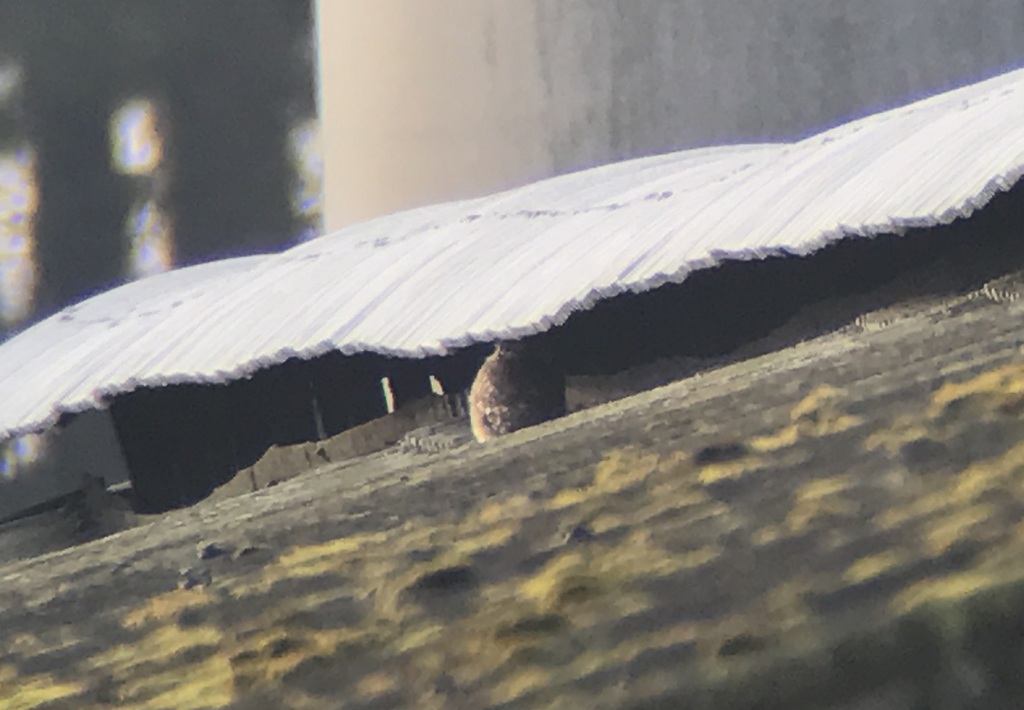
The Little Owl had found a sheltered spot, out of the wind and facing into the morning sun, where it could warm itself. We had a good look at it in the scope. It was fluffed up and facing away from us at first, but then it turned to look towards the sun. A Marsh Harrier was quartering the fields nearby and a large flock of Brent Geese flew over, heading inland to feed.
We continued on our way west, via several other sets of old barns where Little Owls live, but it was clouding over steadily now and there was no sign of any others out this morning. We did find a few Stock Doves on the farm buildings. Several Brown Hares were running around in the fields already. There were lots of Lapwings gathered in large flocks.
A Red Kite flew lazily past us beside the road – the first of a number we saw on our journey today. There were also several Kestrels hovering over the verges or perched in the trees as we passed, and a few Common Buzzards up enjoying the breeze.
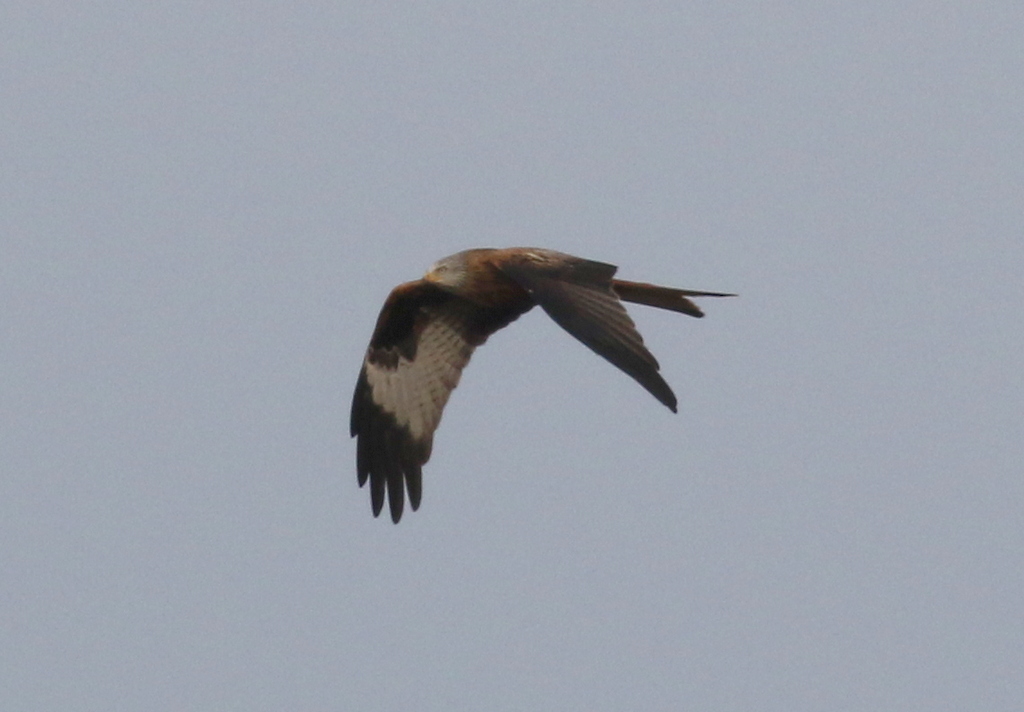
Our next destination was Snettisham. On our way there, it had already started to spit with rain and it was exposed on the edge of the Wash. We had a quick walk up to see if the Shorelark was still here, but we couldn’t find it today. A flock of Goldfinches was feeding along the tideline and flew up ahead of us.
The tide was still out and the Wash was a vast expanse of mud. A large dark mass out in the middle turned out to be a big group of Teal roosting on the edge of one of the muddy channels. The white Shelducks stood out much better against the grey, and were scattered liberally over the whole area, feeding.

A flock of Dunlin was running round on the near edge of the mud, just in front of us, and there were several Redshanks and a Curlew close in too. Most of the waders were further out in the murk, but we could pick out lines of Knot and Bar-tailed Godwits as well as a few Grey Plovers. Something spooked the big flock of Golden Plovers which had been asleep out on the mud and they flew up and over the seawall, dropping down to the fields inland.
It was not a day to be standing out on the edge of the Wash, so we turned our attention back to owls. There have been a couple of Short-eared Owls roosting here and after a short walk we found them, both in their usual spots, unusually choosing somewhere where they can be seen.

We had a good look at the Short-eared Owls through the scope. The first had found a sheltered spot under a bramble bush, but was turned towards us so we could see its bright yellow eyes. The second was perched up in the brambles a little further over. It had its head turned in, but would occasionally look round.
There were a few other birds on the Pit here as we walked round. A selection of ducks, mostly tucked up by bank out of the wind, plenty of Wigeon plus a handful of Gadwall. A few Tufted Ducks and a pair of Goldeneye, which were diving continually. With our mission here accomplished today, having seen the Short-eared Owls, we didn’t linger and headed back to the warmth of the car.
Given the weather, we decided to head round to Titchwell where we could find some shelter in the hides. On our way back to the main road, we stopped to look at a small group of Pink-footed Geese in a field. We could see their dark brown heads, and small dark bills with a narrow pink band, very different from the Greylags we had been seen earlier. A pair of Egyptian Geese were nearby.
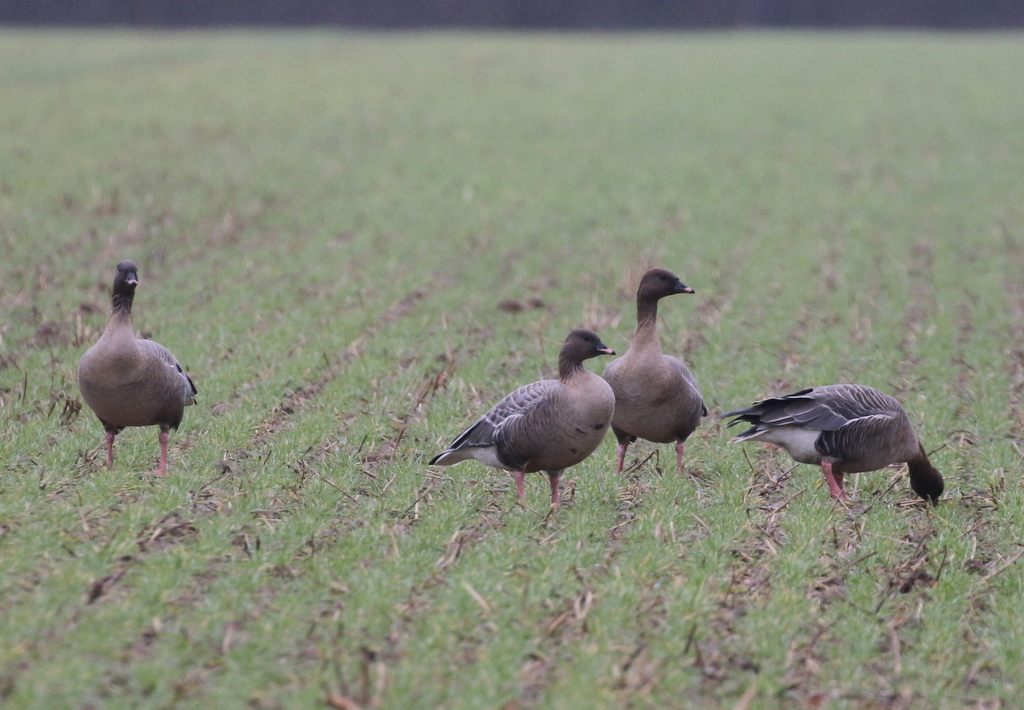
On our way round the coast, we called in briefly at Thornham Harbour. It was damp and blustery but we wanted to have a quick look to see if the Twite were around. As we walked up to the edge of the saltmarsh, they flew over calling and landed down in the vegetation in front of us, a flock of about 20 of them.
The Twite didn’t stop here very long though. After a couple of minutes, they flew up, circled round and dropped down behind us in the car park, to drink and bathe in the puddles. Again they didn’t stay long, but we had a great look at them here for a couple of minutes, before they were spooked by a car door slamming and flew off.
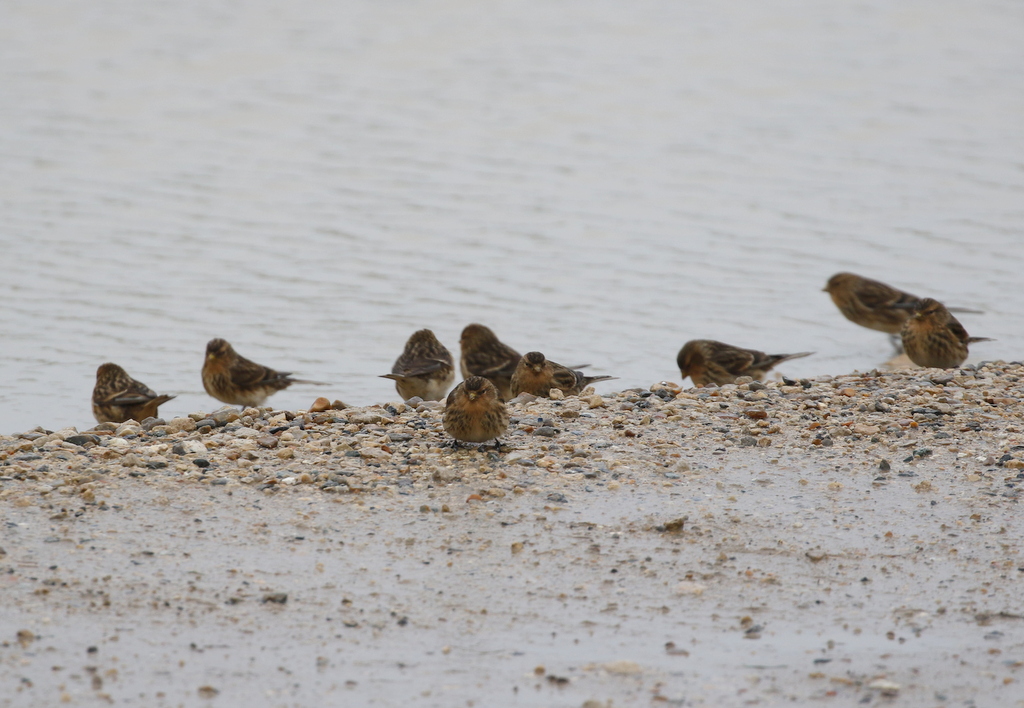
It was time for lunch when we reached Titchwell. A Goldcrest was feeding in the trees right in front of the car when we arrived, just a metre or two from us. We headed over to the visitor centre for a hot drink and while we ate, we kept an eye on the feeders. As well as the regular Chaffinches, Goldfinches and Greenfinches, there were a couple of Bramblings too today, a female on the feeders in front and a brighter male on the ones round the other side.
After lunch, we had a quick walk round Fen Trail and Meadow Trail, in the shelter of the trees. There was nothing to see from Fen Hide today and no sign of the Woodcock under the trees. But we did have great views of one of the Water Rails in the ditch by the main path, picking around in the dead leaves on the bank.
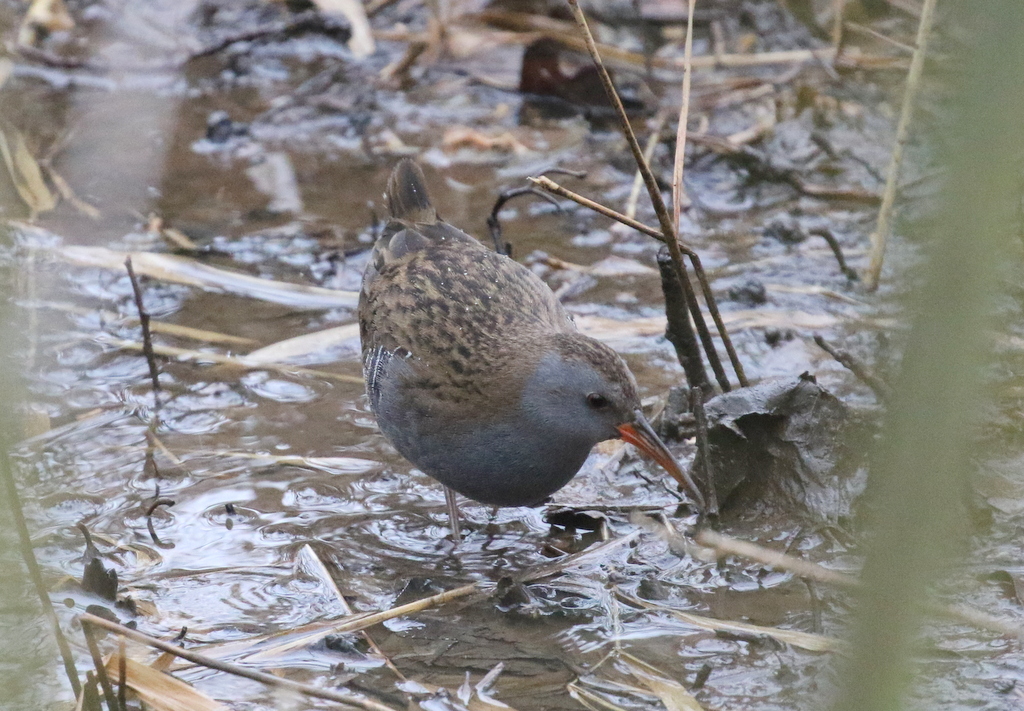
We decided to make a bid for the shelter of Parrinder Hide. On the way out, a Marsh Harrier was circling out over the reedbed, enjoying the wind. A lone Grey Plover was on the edge of the large pool out on Lavender Marsh and several Teal and Wigeon were feeding on the saltmarsh nearby.
The water levels on the freshmarsh are very high through the winter and there was little of note on here today. The raft of Common Pochard and Tufted Ducks were mostly tucked up against the reeds at the back. A lone Curlew dropped in for a bathe and preen on the edge of one of the few exposed bits of dry land.
The other side of Parrinder Hide, overlooking the Volunteer Marsh, was much more productive and we had good views of several species of wader from here. A single Knot was feeding on the mud just below the hide, though a larger group were weaving in and out of the vegetated islands further back. There were also several Dunlin, including a little mixed group with Knot giving a chance to compare the two side by side.
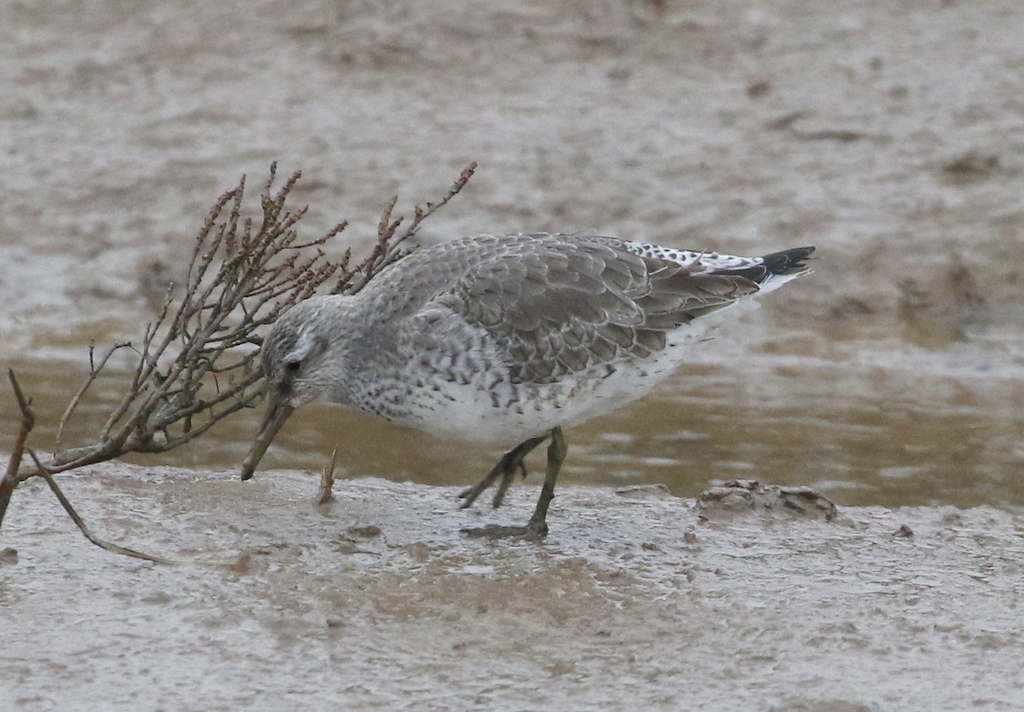
Further over, we could see one or two Grey Plover, standing still surveying the mud for potential food, they were extremely well camouflaged until they moved. A couple of Ringed Plovers were running around as well. We had nice views of a Bar-tailed Godwit feeding on the mud and further back a couple of Black-tailed Godwits were hiding in one of the muddy channels. A Curlew or two and an Oystercatcher rounded off the selection nicely here.
The weather was improving, and it had stopped raining now, even if it was still a but blustery, so we decided to head out further across the reserve. There were some more nice views of waders close to the main path on the Volunteer Marsh, down in the shelter of the main channel. In particularly a Black-tailed Godwit was busy probing deep into the mud, flashing its black tail as it did so.
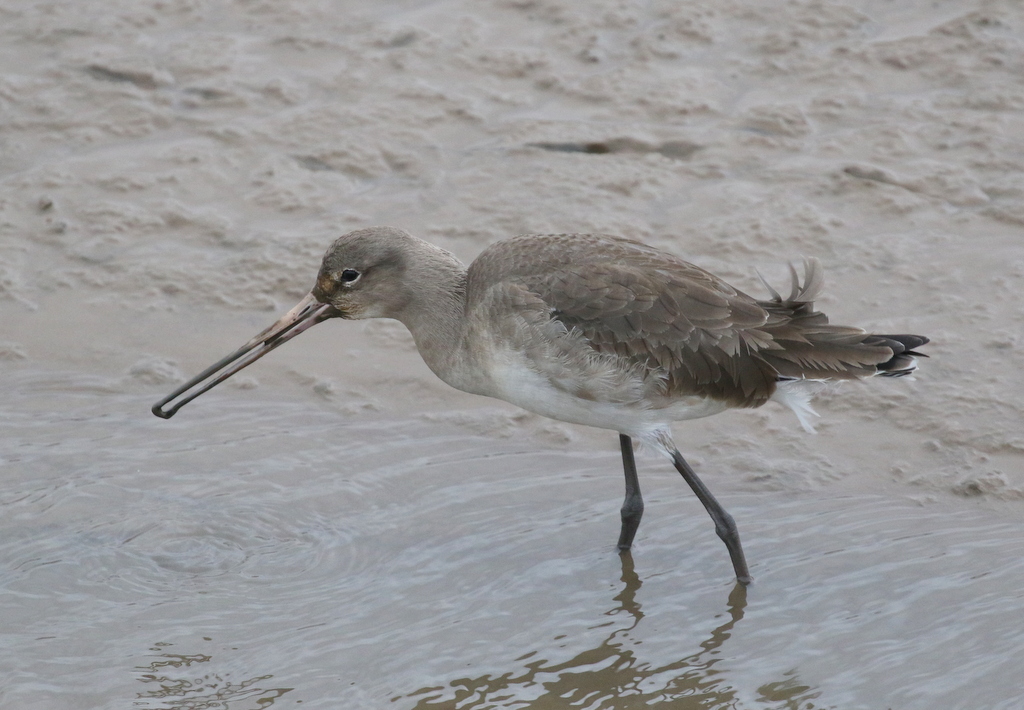
Emboldened by the improvement in the weather, we decided to make a bid for the beach. There were lots more birds on the tidal pools, including a couple of nice close Bar-tailed Godwits which gave us a great chance to compare them with several more Black-tailed Godwits nearby. They were also helpfully flying across occasionally, flashing their very different respective wing and tail patterns.
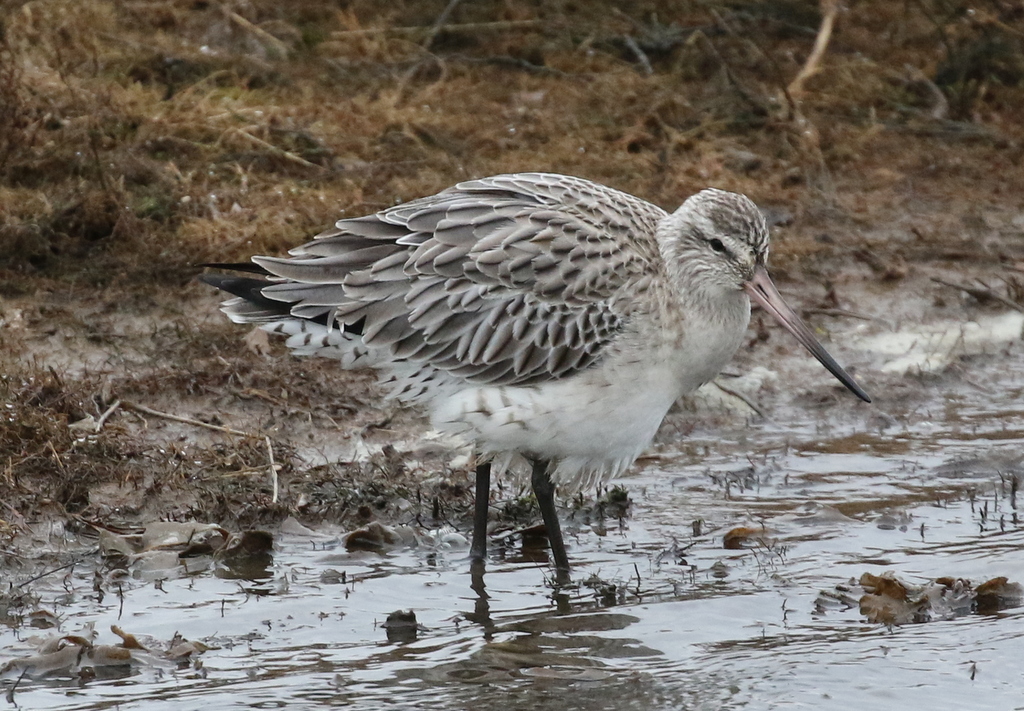
This is also where the Avocets were hiding. We counted at least thirteen today, though they were huddled up roosting along the spit at the back and it was hard to see all of them. Numbers are gradually starting to increase again, as birds start to return. There was also a large roost of Oystercatchers on the saltmarsh nearby.
A pair of Goldeneye were diving out on the Tidal Pools today, giving us better views than we had managed earlier at Snettisham. We had a great look at the male through the scope. There were also a few Pintail out here, including a couple of smart drakes, showing off their long pin-shaped central tail feathers as they upended to feed in the shallow water. One of the Little Grebes was diving just beyond the bushes right below the path.
It was nice to get out to the beach and into the shelter of the dunes, out of the wind. There were more waders out on the beach, even though it was around high tide now. More Bar-tailed Godwits were lined up along the water’s edge, with one or two Sanderlings running around in between them. A Turnstone walked past, picking at the seaweed along the high tide line, and another Sanderling ran past too.
It wasn’t as choppy as it might have been, given the wind, so we managed to find a few birds out on the sea. There was a group of six Long-tailed Ducks diving just offshore, including several smart drakes. We got them in the scope, but they took off before everyone had a chance to get a good look at them. They circled round offshore, before flying and landing back down much further out.
A line of dark, blackish Common Scoters was out there too, as well as a good number of Goldeneye. A couple of Guillemots were swimming just beyond the ducks and there were several Great Crested Grebes out on the water, but a Red-throated Diver was harder to see, diving constantly. Several Little Gulls flew past while we were watching the sea, the adults flashing alternately their black underwings and pale silvery grey upperwings.
The afternoon was getting on now and we had an appointment elsewhere at dusk, so we made a quick dash back to the car, heads down into the wind. We headed off inland on our way back east and checked out a couple of places in passing to see if there might be any more Barn Owls out, but they were probably in no hurry to come out this evening, given the wind.
When we got to the woods and started to walk along the track, we hadn’t gone very far when a male Tawny Owl started hooting from the trees behind us. It was an auspicious start, as we weren’t sure how active they would be given the wind tonight. We turned and walked back in the direction of the sound, and positioned ourselves where we know that particular Tawny Owl likes to perch up in the trees sometimes.
After a short wait, a dark shape flew towards us through the tops and landed in the back of an ivy-covered tree in front of us. Unfortunately, we couldn’t see it from where we were standing so we stood very quietly and were rewarded a few seconds later when the Tawny Owl flew again, right over our heads and into a tree close by. They are big owls up close, with very broad, rounded wings when they fly. It turned to look down at us.
We had a great view of the Tawny Owl perched there for a minute or so, but it knew we were watching it from below and was spooked by a car passing on the road. It flew off again deeper into the trees. We knew roughly where it had gone and followed after it. Then helpfully it started hooting again, so we could work out exactly where it was and get it in the scope. We had a good view of it silhouetted against the last of the light, high in the branches, hooting, turning round.
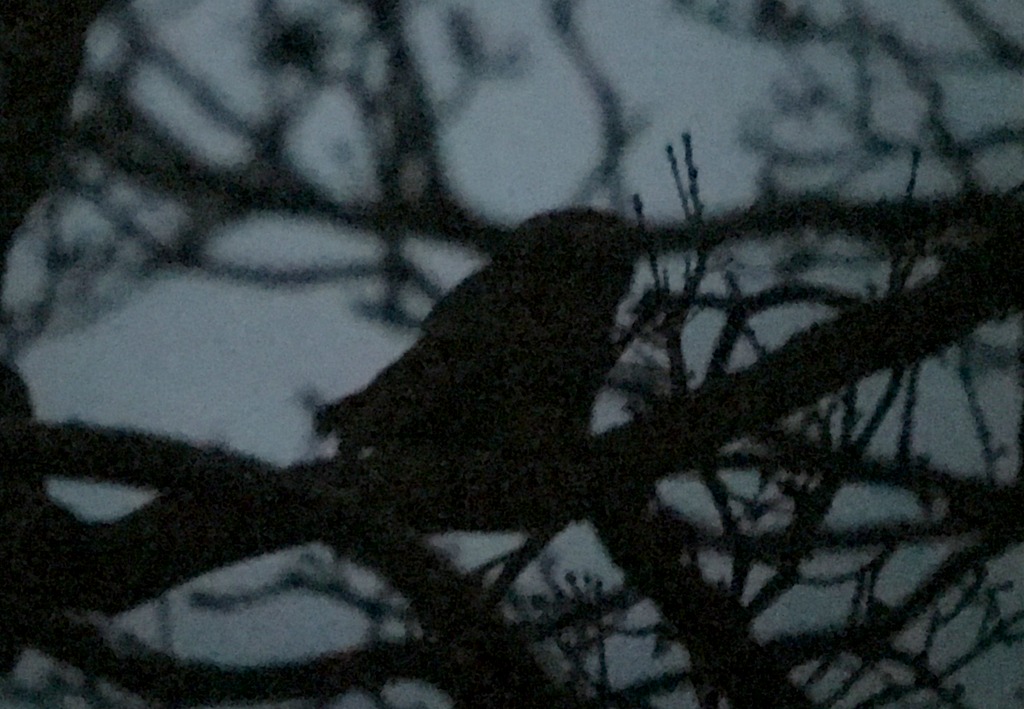
The Tawny Owl flew off a little further into the trees, where it landed briefly and called, before dropping away again. As we walked back to the car, we could still hear it hooting, a great way to end the day.
















